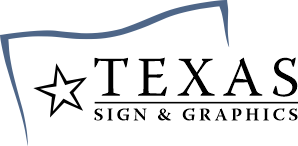Winning government, public, and private signage contracts can be a game-changer for sign shops, providing steady work and lucrative opportunities for growth. However, navigating the bidding process can be complex and competitive. When we first started bidding these types of projects about a decade ago, we had no idea of how to even read construction plans or interpret specifications, let alone know where to find the signage details in those lengthy documents. It’s safe to say that we’ve learned a lot when it comes to bidding over the last 10 years. So in this guide, we’ll share some strategies and tips to help you increase your chances of success when bidding on signage projects, particularly in Texas.
Understanding the Landscape:
Before diving into the actual bidding and quoting process, it’s essential to understand the landscape of contracting in Central Texas. Government agencies, including schools and universities, along with private or public builds like hospitals and office buildings, often have specific procurement procedures and requirements that must be followed. Familiarizing yourself with these procedures and building relationships with key decision-makers can give your company a competitive edge.
It’s important to understand the path that lot of renovation, addition, and new build projects take. Most of the time, the “owner” of the project actually sends out the invitation to bid to local general contractors. The general contractors are responsible for turning in final numbers to the government agency, therefore the GCs will issue bid requests to subcontractors for each scope of the project. That would include us, the signage manufacturers and installers, so getting to know the local general contractors and project managers is key in being invited to bid on upcoming projects.
Researching Opportunities:
The first step in winning contracts is identifying relevant opportunities. Government agencies and general contractors will typically advertise projects through various channels, including online portals and procurement websites. Signage companies should regularly monitor these platforms for new opportunities that align with their capabilities and expertise. Getting on email lists either directly from GCs or from these bidding platforms can make sure you’re first in line to be notified of upcoming opportunities. Some platforms even offer paid ad slots for subcontractors so GCs can find them at the top of the list when searching for subcontractors in specific trades or service locations.
When researching opportunities, it’s also important to pay close attention to project specifications, budget constraints, and deadlines. Thoroughly reviewing the request for proposals (RFPs) or bid documents will help ensure that your company can meet the project requirements and submit a competitive bid to spec.
Building Relationships:
Building strong relationships with general contractors and procurement officials can significantly enhance your chances of winning contracts. Attend industry events, networking functions, and procurement conferences to connect with decision-makers and learn about upcoming projects. Establishing a reputation for reliability, quality, safety, and professionalism can make your company stand out in a crowded field of competitors and helps GCs remember to invite you to bid on their projects.
Additionally, consider partnering with other local businesses or subcontractors to strengthen your bid. Collaborating with companies that offer complementary services or expertise can enhance your capabilities and increase your competitiveness. For example, if you become acquainted with local electricians, HVAC, or fire extinguisher subcontractors, you might be able to provide the identification tags they need to label their work in their specific trades.
Preparing a Competitive Proposal:
Once you’ve identified a promising opportunity, it’s time to prepare a competitive proposal. Start by carefully reviewing the RFP and understanding the evaluation criteria. Tailor your proposal to address the specific needs and requirements outlined in the RFP, highlighting your company’s unique strengths and capabilities.
When bidding to government agencies directly, they’ll sometimes request information about your company or why your products might be the best value for their needs. Be sure your written proposal clearly articulates how your company will plan to deliver value to the agency, emphasizing factors such as quality, reliability, timeliness, and cost-effectiveness. Provide detailed information about your experience, qualifications, and track record of success, including similar and relevant projects completed for other clients.
Consider including references, testimonials, or case studies that demonstrate your company’s ability to meet or exceed client expectations. Highlight any certifications, accreditations, or awards that showcase your company’s commitment to excellence and compliance with industry standards. Prioritizing safety on jobsites is paramount so if your team has earned any safety awareness certificates while on previous jobs, this would be an excellent time to showcase them.
Where to Find the Sign Details:
If you’ve never had the opportunity to review construction documents, it can be overwhelming. Some projects that are being issues directly from the owner or government agency might be for signage only. However, if you’re bidding to a general contractor, chances are they’re looking for all trades. Therefore, they’re going to issue the complete set of drawings and documents pertaining to the entire project. While all project documents are a little different depending on the architect designing the building and the specific project requirements, but knowing where to start looking for the signs will help you save value time in the planning process.
Typically in the specifications, signage will be located somewhere in Section 10 (or Division 10). They may be labeled as Identifying Devices, Room Signs, Signage, or other verbiage, but typically Section 10 is where they’ll be located.
As far as the plans or drawings go, signs can be located in a number of places. Typically they’re located in the “A” pages (A for Architectural), but the specific page number may vary. Sometimes there will be designated pages with sign schedules, drawings, and placement maps, whiles other times they’re hidden on the door schedule page. Finding them in the plans might be a little more tricky, but typically combing through the Architectural pages is where you’ll find them so definitely start there.
Submitting a Competitive Bid:
When submitting your bid, attention to detail is crucial. Ensure that all required documents are completed accurately and submitted on time. Bids submitted after the deadline are typically not considered. Double-check your pricing to ensure that it’s competitive, while still allowing for a reasonable profit margin.
In your bid, also be sure to include pricing for any additional items or services that may be required if awarded. This can include installation services, permitting, fingerprinting and background checks, drug screening and badging, samples of each sign to review and approve prior to production (during what’s called the “submittal” process), multiple mobilizations (trips) to the site, certifications needed for onsite workers like OSHA or CPR training, extended warranties, or work that will need to be performed outside of normal business hours. By reviewing all the bid specifications, plans, and addenda thoroughly, you can be sure to include these extra expenses in your scope of work up front and know that you’re covered for the entire scope of work for each specific project.
If the RFP allows for questions or clarifications (request for information or RFI), don’t hesitate to seek clarification on any ambiguous or unclear requirements. Asking thoughtful questions can demonstrate your company’s commitment to understanding and meeting the client’s needs.
Finally, follow up on your bid after submission to ensure that it has been received and to address any additional questions or concerns that may arise. Demonstrating proactive communication and responsiveness can further differentiate your company from competitors.
Winning signage contracts requires a strategic approach, meticulous preparation, and a commitment to excellence. By understanding the landscape, building relationships, preparing competitive proposals, and submitting thorough bids, signage companies in Central Texas can increase their chances of success in the government contracting arena. With persistence, professionalism, and perseverance, your company can secure lucrative government projects that drive growth and success.

